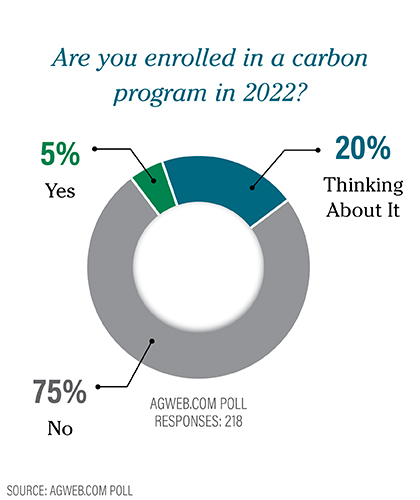Growing Pains: Companies Focus on Creating a Carbon Market Foundation

Welcome to the messy middle. Today, more than a dozen opportunities exist for farmers to be compensated for change practices that lead to carbon sequestration or a reduction in greenhouse gas emissions. While companies have big aspirations for carbon programs, they are simultaneously recognizing changes that need to be made to increase participation.
This means some simplification to the program parameters and more resources to help farmers transition to change agronomic practices.

ONE COMMON THREAD
“Right now, carbon is not considered a commodity,” says Shelby Myers, economist at American Farm Bureau Federation. “What turns this into an actual market will be price transparency and less uncertainty. If you draw a market development curve, we’re in the growth stage. It’s a lot of hype and a lot of hope until more development occurs.”
The baseline for participation in carbon markets is data, which Myers explains is necessary to:
- Certify a practice happened.
- Quantify environmental benefits.
- Verify, by third party, outcomes generated by the credit happened the way they said it would.
RISING TIDE LIFTS ALL BOATS
Nutrien launched its Sustainable Nitrogen Outcomes program in an effort to simplify eligibility as it pays farmers to reduce the nitrogen rates they apply by 5% to their corn, cotton or wheat crops.
“It’s an easier lift for farmers,” says Sally Flis, Nutrien Ag Solutions director of sustainable ag strategic partnerships. “It doesn’t matter how you get to the 5% rate reduction. It could be variable rate, strip-till or another method to adjust the overall rate applied to a field.”
From Nutrien’s 2021 pilot program, Flis says they learned a lot about the pieces required to build a large-scale carbon program. Mostly, she points to an overall lack of the necessary data.
“We should all focus on helping farmers establish high-quality data, so they are up-to-date with higher requirements in the future,” she says. “Carbon, and the need for reporting production practices, isn’t going away.”
In late 2021, Truterra announced it had facilitated more than $4 million in payments to farmers as part of its carbon program. Company leaders have recognized a need to create a pipeline of farmers who can participate in the program by encouraging more soil health practices.
As such, Truterra announced a network of transition specialists to help facilitate the implementation of those agronomic practices alongside its retail network agronomists and their farmer customers. These individuals will offer specialized agronomic support — providing perspective to the short-term steps for long-term outcomes.
The goal is to have more farmers interested in the change practices, which would create a larger pool of farmers potentially ready to engage with carbon markets.
The marketplace for soil organic carbon could reach $3 billion to $6 billion by 2030, says Jason Weller, president of Truterra.
Visit our Carbon Innovation Center to view resources, see the current carbon markets and more.
Margy Eckelkamp reports on ag retail, carbon markets, input trends, machinery and technology.







